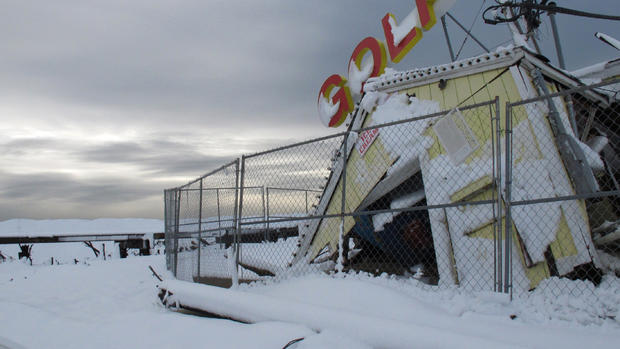Power outages on Long Island spur lawsuits and punches in Sandy's wake
Updated at 3:38 p.m. ET
HICKSVILLE, N.Y. Utility workers on New York's Long Island have faced harsh criticism for failing to bring power back to communities more than two weeks after being hit by superstorm Sandy.
Now they're facing legal action and closed fists.
New York attorney Kenneth Mollins filed a lawsuit in state Supreme Court Tuesday claiming negligence by two Long Island power companies after Sandy and a subsequent nor'easter. Mollins said the lawsuit seeks unspecified damages.
A spokesman for the Long Island Power Authority had no comment on the lawsuit. LIPA's electrical contractor, National Grid, also was named in the suit. A spokesman did not respond to a request for comment.
Meanwhile, a Nassau County, N.Y., police press release said a man was punched in the face on Friday night while walking outside a restaurant in Long Island's East Meadow. The release did not identify the man by name or occupation, but The Ledger of Lakeland, Fla., reports that he was a utility worker from Lakeland.
The assailant fled in a dark BMW. No arrests have been announced.
The Lakeland Electric worker, John Applewhite, 34, told the newspaper that he doesn't know why he was attacked. Applewhite said nothing was stolen. He attributed the attack to "a bad apple."
Many of LIPA's customers want to deliver the power company a message, just in a less violent way.
"I'd tell them, get off your rear end and do your job," Priscilla Niemiera, a 68-year-old Seaford resident, said. Well, she would if she could get in touch with anyone.
Over the last two weeks since she lost power from Sandy, she says, "every time I called they hung up on me."
While most utilities have restored electricity to nearly all their customers, LIPA still has tens of thousands of customers in the dark.
"I want to see my lights back on," Larry Kushel, of Island Park, told CBS New York station WCBS-TV. "I want to see gas coming into the house so I can get some heat. I'm living in the dark."
Kushel and his wife Jean are tired of hearing politicians squabble about who is to blame for LIPA's dysfunction. They are going into week three on generator power while most of their neighbors are living almost completely in the dark.
"It's been such devastation down here, that to hear politics, that's just not the first thing on my mind," Jean Kushel told WCBS-TV. "I wish that we're getting some more support, but we're obviously not going to get that."
The company said that the storm was worse than anyone could have imagined and that it didn't just damage outdoor electrical lines; it caused flooding that touched home and business breaker boxes. It acknowledged that an outdated computer system for keeping customers notified has added to people's frustration.
But some say the government-run utility should have seen it coming. It was recently criticized in a withering state report for lax preparation ahead of last year's Hurricane Irene and for the 25-year-old computer system used to pinpoint outages and update customers.
"It's antiquated. I think they're negligent," said Phil Glickman, a retired Wall Street executive from South Bellmore who waited 11 days to get electricity back.
LIPA has restored power to more than 1.1 million homes and offices. The utility says that more than 14,000 homes and businesses still lack power but that most should have it back on by Wednesday. An additional 38,000 won't because of lingering flood damage.
The utility says there also are some along Long Island's south shore and Rockaway Peninsula that had water damage to electrical panels and wiring, so their service can't be restored without an inspection and possibly repairs.
At its peak, the storm knocked out power to 8.5 million customers in 10 states, with New York and New Jersey bearing the brunt. Those outages have been nearly erased, though Consolidated Edison, the chief utility in New York City, has cited problems similar to LIPA's, saying about 16,300 customers in flooded areas of Brooklyn, Queens and Staten Island can't get service until their internal electrical equipment is repaired, tested and certified.
Niemiera, whose finished basement in Seaford flooded, said her house needs to be inspected and she can't get any answers. "I think LIPA should be broken up into small companies and it shouldn't be a monopoly anymore because this is every single time we have a disaster. And then they raise the rates. We're paying very high rates. We're paying high taxes, high electric. Everything," she said.
LIPA, whose board is chosen by the governor and lawmakers, contracts with National Grid for service and maintenance. Last year, its board chose a new contractor, New Jersey's Public Service Enterprise Group, which will take over in 2014. Gov. Andrew Cuomo criticized the storm response of all New York utilities in the region, saying their management had failed consumers.
Asked Monday about LIPA board vacancies he hasn't filled and whether he takes responsibility for what's happening there, Cuomo called the authority a holding company that became "an intergovernmental political organization." He said National Grid was the actual Long Island power provider, one of the monopolistic state-regulated utilities. "They're going to be held accountable," he said, citing lack of communication and preparation and even proposing they consider rebates instead of rate hikes.
On Tuesday, Cuomo's office announced that he ordered an investigation of how utility companies prepared for and reacted to Sandy. He exercised his authority under the state's powerful Moreland Commission law that provides for subpoenas and other action.
Cuomo had previously threatened to hold public hearings on his concerns. The commission will be run by former Attorney General Robert Abrams and Cuomo's financial services director, Benjamin Lawsky.
A state report criticized LIPA in June for poor customer communications after Irene last year and for insufficient tree trimming. The Department of Public Service noted major problems in telling customers estimated power-restoration times, faulting its computer system, which a consultant had found deficient back in 2006.
LIPA acknowledged that customers aren't getting the information they need, partly because of the system, which it is updating. Authority officials said the new system will be operating next year.
"It is a huge computer system. After Irene we immediately accelerated that process, and even at that it is still an 18-month to two-year process," LIPA's chief operating officer, Michael Hervey, said Monday. "We would have liked to have had it up and running for now, but it's just such a large magnitude computer system that it takes that long."
Hervey said the company will be working with remaining customers over the next several weeks as they get their homes repaired. "They can't be safely re-energized from an electrical standpoint," he said. "We are ready to service those areas, but they are not ready to take it right now."
John Bruckner, president of National Grid Long Island transmission and distribution, said he had about 15,000 people working on restoration, including 6,400 linemen from all over the U.S. and Canada.
Matthew Cordaro, co-chairman of the Suffolk Legislature's LIPA Oversight Committee and a former utility executive, said Con Ed and Public Service Electric & Gas New Jersey did a good job responding to the storm, and LIPA didn't.
While a storm of that magnitude would challenge any electricity provider, he said LIPA is probably one of the most poorly run utilities and has a "crazy" public-private organizational structure that's fraught with problems and raises questions of accountability.
In New Jersey, post-Sandy recovery moved ahead, the odd-even system of gas rationing ending Tuesday. Meanwhile, New York City Mayor Michael Bloomberg said rationing seems to have eased the post-storm gasoline crunch, but he's not sure when he'll lift the restriction.

